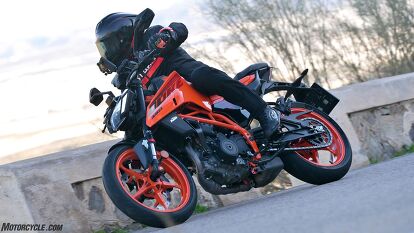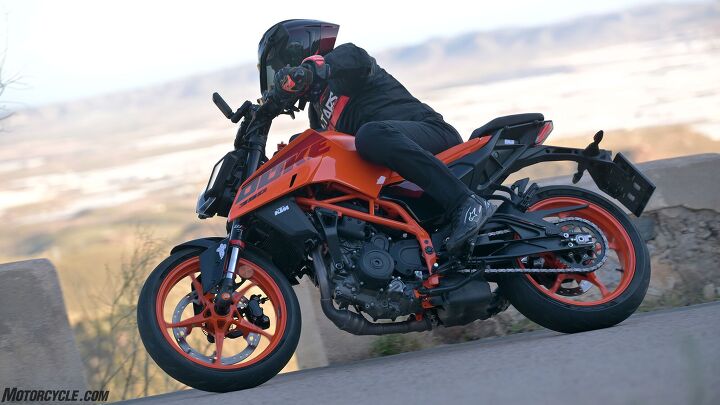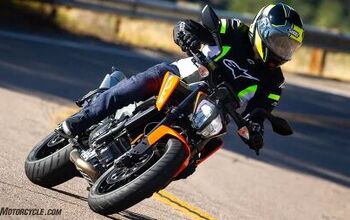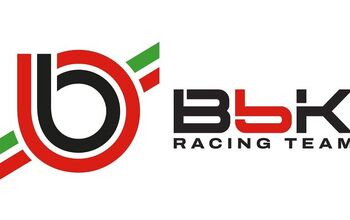2024 KTM 390 Duke Review – First Ride

Premium treatment for the baby Duke
Like many things in life, perspective is everything. Here in the US, KTM’s 390 Duke has been the smallest member of the Duke family (although that’s no longer true as the 250 and 200 Dukes cross the ocean, too). As the baby Duke in America, we generally look at it with kid gloves, a cute learner bike for someone to start with before coming up through the ranks. Here’s the thing: in many markets, especially Asian ones, the 390 Duke is the cream of the Duke crop. Where we start on 390s while aspiring to move up to 990 Dukes and maybe even 1390 Super Dukes, other parts of the world start on 125 Dukes before hopping on the 250. They’ve “made it” when the 390 gets in their hands. It’s the same bike, just received in two very different ways. See? Perspective.
2024 KTM 390 Duke
A complete refresh breathes new life into the 390 Duke, as the engine is a true 390 now. A stiffer chassis, beefed up electronics, and premium touches throughout has elevated the 390's status beyond that of a beginner bike.
Editor Score: 82.5%
Engine | 16/20 | Suspension | 12/15 | Transmission | 8.5/10 |
Brakes | 8/10 | Instruments | 5/5 | Ergonomics | 8.5/10 |
Appearance | 9/10 | Desirability | 8.5/10 | Value | 7/10 |
Highs
- KTM's given the 390 top-notch upgrades, inline with the 990 and 1390
- An honest 400cc Single
- The TFT display is great to stare at
Sighs
- Can this engine keep up with the competition?
- Highest price in the class
- Quickshifter optional
It’s under this lens that KTM have completely revamped the 390 Duke for 2024. Understanding that the 390 is the crown jewel in some markets, KTM saw fit to give it the royal treatment when conducting this overhaul, just as it does with the bigger Dukes. That amounts to nicer finishes, tighter gaps, better electronics, and a whole bunch of stuff that you’ll probably never see, but affects the overall bike in the long run. KTM knows people like numbers, and after doing the math, they say 90% of this 390 Duke is different from last year’s version.
What’s New
The two big talking points are going to be the styling and the engine. For the former, the 390 Duke is modeled more inline with its 990 and 1390 bigger brothers and you can see that influence in the side fairings that now extend lower and farther out beyond the fork tube. But there are more styling differences than that, as you can see below.
Not only is the fairing different – everything’s different. From the wheels to the subframe, when you compare new and old 390s, it’s easy to believe that 90% of the bike is new. In fact, we cover a little more detail with the differences in this story from last year when the 390 and 250 Dukes were announced. Speaking of which, it’s important to note that the 390 is a completely different platform than the 250 and 125 Dukes also in KTM’s portfolio (though the 250 and 125 *do* share the same platform).
Having attended the introduction for the 390 Duke, however, we learned even more that wasn’t covered in our First Look. Clearly the single-cylinder engine is bigger for this year, measuring 399cc compared to the 373cc, but it’s also lighter than before and more reliable, too. Oil change intervals are at 6,000 miles (10,000 km) and valve checks are scheduled for 12,000 miles (20,000 km).
Housing this engine is a new frame, which features down spars that are now on the outside of the swingarm pivot instead of on the inside. This helps increase chassis stiffness, which is what KTM were going for, as they felt the previous 390 had too much flex. You’ll also notice the linkage-less shock is now mounted offset to the right of the bike. This frees up space to allow for a bigger airbox, and while they were at it, KTM designers moved the air intake from under the seat to in front of the seat, resulting in a lower seat height. It’s now at 32.2 inches, down from 32.6 inches previously.
As for premium upgrades either directly borrowed, or inspired by its bigger Duke siblings, the 390 shares the same 5-inch TFT display as the 990 and 1390, so you get full, clear, and bright gauges staring back at you. There are multiple ride modes as well as full connectivity via Bluetooth, and new for this year, the 390 gets a Track riding mode and – get this – launch control! If you feel so inclined to launch your 390, with the mode turned on you can twist the throttle and the ECU will limit revs to 7,000 rpm. From there, all you need to do is ease off the throttle (don’t dump it!) and away you go. Speaking of getting off and going, let’s talk about what it’s like to ride.
Riding Impressions
The beauty of small displacement bikes is that they’re also light, and at 363 lbs ready-to-ride with a full tank of fuel, the 390 Duke is no exception. Sitting on the bike, you can feel how light it is between your knees as you shift your weight from one foot to the other. Reach to the ground is easy too, thanks to the lower seat height from before, plus the added benefit of having a relatively narrow junction where the seat meets the fuel tank.
Read more: 2024 KTM 990 Duke Review – First Ride
With the engine running, the TFT display is in full view, showing you the information you need to know. If you’re experiencing a TFT display for the first time, whether because you’re new to riding or don’t expect that kind of display from a lightweight bike, it’s clear to see how this can be viewed as a premium product in an otherwise budget-conscious field of motorcycles. The TFT is simply cool, and for it to be offered on the 390 also enhances that premium feel for those riders in markets where the 390 is the biggest Duke offering in their country.
But beyond the display, you can also experience premium components in all of the touch points. Toggling through the different menus on the TFT display means thumbing the left switchgear, which itself feels like the 990 and 1390 with positive engagement each time you push a button. As a bonus, the buttons themselves are backlit so you can see each of them at night and/or in dark conditions. This is an added bonus often overlooked on many motorcycles.
Put the bike in gear and the 390 rolls away with a little throttle and a gentle release of the clutch lever with its light pull. Despite the bigger engine compared to years past, this is still a 399cc Single after all, and you’re going to find yourself twisting that throttle and rowing through the gears. Our particular ride day was bitterly cold and very windy. Add in the fact that our lead rider was aboard a 990 Duke and we knew from the onset that the little 390 was going to get taxed.
First the good: As you’d expect from such a light bike, you can toss the 390 Duke around like a toy. The tight and twisty Spanish roads surrounding our base at the Almeria circuit were the perfect setting for the 390, as direction changes were a breeze – and there were a lot of them. The stiffer frame adds to the sense of security you get midcorner, as the connection between rider and chassis is very solid. It’s not that the previous Duke was vague, but now the 390 feels more planted and confident with less flex. Add in the fact you have adjustable WP suspension at both ends, and wheels that shave off nearly 10 lbs from last year’s bike, and the premium feel KTM promised isn’t just marketing fluff. Heavier riders in our group felt the need to add more preload to the shock, which was easy enough to do on the side of the road with the included preload tool. They reported quicker steering as a result. I, however, didn’t feel the need to make those changes on my bike.
With a claimed 45 horses and 29 lb-ft of torque, the 390 isn’t exactly lighting the world on fire, but the fueling coming out of slow-speed corners is smooth with hardly a hiccup. You can feel confident giving handfuls of throttle because the little engine won’t try to launch you into orbit (not that you should ham-fit it, but you get the idea) Vibrations from the Single cylinder engine are present, but not enough to really complain about. It’s a nice entryway for newer riders, and getting to stare at the clear and colorful 5-inch TFT display is a nicety that’ll spoil newer riders if or when they venture onto other bikes without it.
A 320mm single front brake disc is paired with a four-pot radial-mount caliper that offers plenty of stopping power, though picky riders like myself might prefer pads with more bite and a radial master cylinder for extremely limited play at the lever, but maybe we’re getting ahead of ourselves. It is a nice touch to see steel-braided brake lines, though…
The bad? It’s a single one (pun not intended), but it’s an important one: the engine. Getting a little more power from a displacement bump is nice, but it still doesn’t feel like it’s enough – especially considering the level of the competition in this space. We’re primarily talking about the Kawasaki Z500, but there are others. Maybe our impressions are skewed because of the fact we had blustery winds blowing us around even when we were riding straight, but the 390 Duke struggled to reach triple digit speeds. Ridden on its own it’s a perfectly capable motorcycle, but with the benefit of history and having ridden some of the competitors in this space, we wonder if the modest displacement bump will be enough for the little Duke.
Actually, there are two cons. The second being price. At $5,899, the 390 Duke is one of, if not the, most expensive bikes in this category. The aforementioned Z500 isn’t far off at $5,599, but it’s still less than the KTM and comes with twice the cylinders. It’s a stretch to call the CB300R a competitor, but at $5,149, Honda has priced it in the conversation (we’d pick the KTM between these two, in case you couldn’t tell). However, the real trump card here is Triumph’s Speed 400. Starting at $4,995, if you’re shopping within this space, then that thousand-odd dollar price difference is significant. Granted, the Duke offers better (and adjustable) suspension in comparison, but some would argue the Triumph is styled much better and could have better resale value – an important factor when said rider is ready to move up to something bigger.
The Last Word
Ultimately, I’m torn about this new 390 Duke. The premium treatment KTM has bestowed upon it truly is nice, and if you live in a market where the 390 is the largest version you get, you should be proud to own one. Its sporty nature has been improved through the stiffer frame and adjustable WP suspension, and who doesn’t like that TFT display? It’s a standout feature the competition should be jealous of. I even like the way it looks. As we all know, the Duke family styling is controversial, but the 390 can be considered the least offensive. Lastly, if you’re seriously considering one, spend the extra money for the bi-directional quickshifter. You’re going to shift a lot on little bikes, so you might as well have some assistance to make your life easier.
Coincidentally, you’ll also be shifting a lot because you’ll need to keep the engine within its powerband. Without having ridden the competition (Kawasaki and Triumph, mainly) side-by-side, it’s hard to really say if these concerns are over exaggerated, but it’s still alarming to experience a motorcycle struggle to break the triple-digit mark, headwind notwithstanding. It’s lofty price tag within the class also doesn’t do it any favors, but it’s an easy argument to say the 390 offers a lot of performance and tech for the money.
Ultimately, we’re just going to have to settle this once and for all with a good old fashioned shootout.
In Gear

- Helmet: Alpinestars Supertech R10
- Jacket: Alpinestars SMX Air
- Airbag: REV’IT! Avertum Tech-Air
- Gloves: Alpinestars Equinox Gore Tex X-trafit (Discontinued)
- Pants: Alpinestars Copper v3 Riding Jeans
- Shoes: Alpinestars Superfaster
2024 KTM 390 Duke Specifications | |
|---|---|
Engine Type | Single Cylinder, 4-Stroke, DOHC |
Displacement | 398.7 cc |
Bore/Stroke | 89/64 mm |
Starter | Electric; 12V 8Ah |
Transmission | 6 Gears |
Fuel System | Bosch EFI, 46 mm Electronic Throttle Body |
Lubrication | Wet Sump |
Cooling | Liquid Cooling |
Clutch | PASC Slipper Clutch, Mechanically Operated |
Ignition | Bosch EMS with Ride-By-Wire |
Frame | Steel Trellis |
Subframe | Bolt-on Cast Aluminum |
Handlebar | Aluminum, Tapered, 26/22 mm |
Front Suspension | 43mm WP APEX USD fork with adjustable rebound and compression; 5.9 inches of travel. |
Rear Suspension | WP APEX Monoshock with adjustable preload and rebound; 5.9 inches of travel. |
Front Brake | Bybre four-piston radial-mount caliper with 320mm disc |
Rear Brake | Bybre two-piston radial-mount caliper with 240mm disc |
ABS | Bosch 9.1MP Two-Channel cornering ABS and Supermoto ABS |
Front Wheel | 3.00 x 17" |
Rear Wheel | 4.00 x 17" |
Front Tire | 110/70ZR17 |
Rear Tire | 150/60R17 |
Wheelbase | 53.4 ± 0.6 inches |
Seat Height | 32.2 inches |
Tank Capacity | 3.9 gallons |
Curb Weight | 363.7 pounds (claimed) |
We are committed to finding, researching, and recommending the best products. We earn commissions from purchases you make using the retail links in our product reviews. Learn more about how this works.
Become a Motorcycle.com insider. Get the latest motorcycle news first by subscribing to our newsletter here.

Troy's been riding motorcycles and writing about them since 2006, getting his start at Rider Magazine. From there, he moved to Sport Rider Magazine before finally landing at Motorcycle.com in 2011. A lifelong gearhead who didn't fully immerse himself in motorcycles until his teenage years, Troy's interests have always been in technology, performance, and going fast. Naturally, racing was the perfect avenue to combine all three. Troy has been racing nearly as long as he's been riding and has competed at the AMA national level. He's also won multiple club races throughout the country, culminating in a Utah Sport Bike Association championship in 2011. He has been invited as a guest instructor for the Yamaha Champions Riding School, and when he's not out riding, he's either wrenching on bikes or watching MotoGP.
More by Troy Siahaan




































Comments
Join the conversation
You claim it’s more reliable, which is greatly needed from a brand and bike with so many reliability problems, but you don’t mention how they accomplish this. Sounds extremely fishy. At least you finally touched on KTM’s spotty reliability.
Well, the obvious answer may be cost or that bikes in foreign markets may be limited to 400cc, but if you're going to re-design the engine from the ground up, why not just take one 890R or 990R cylinder (445cc vs 474cc) and go from there? That'll get you close if not into the 50hp range.
The other thing I'll say is that a handlebared standard style bike gets significantly slowed down in strong headwinds (even my 890R is susceptible), so I'd wait until you're on even ground vs. other bikes.
I can't speak to reliability issues on my KTM yet, as its still under 4000 miles, but my only complaint is a limp turn signal stalk (on the other hand, my 08 CBR1000RR has 35+ track days and is still going strong)